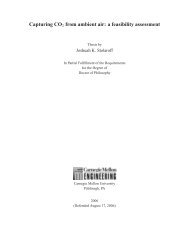Royal Society - David Keith
Royal Society - David Keith
Royal Society - David Keith
You also want an ePaper? Increase the reach of your titles
YUMPU automatically turns print PDFs into web optimized ePapers that Google loves.
ocean fertilisation, there may be a time lag after<br />
abandonment for the effects of methods to cease, if they<br />
have caused environmental changes. However, the issue of<br />
reversibility applies to more than just the ability to ‘switch<br />
off’ the technology. The solar radiation management (SRM)<br />
methods for example do not affect the greenhouse gases<br />
in the atmosphere and if efforts to remove CO 2 are not<br />
undertaken in parallel, the abandonment of such methods<br />
would result in a rapid temperature rise. And while there<br />
would be no immediate ill-effect from ‘switching off’<br />
air capture technologies, any moves to abandon these<br />
technologies could meet strong resistance due to the<br />
investments made in construction and maintenance of<br />
the physical infrastructure; just as getting vested interests<br />
to abandon the use of fossil fuels is a challenge for<br />
conventional mitigation.<br />
4.3 Ethics<br />
Decisions to deliberately modify the Earth’s climate<br />
undoubtedly raise a number of different ethical issues.<br />
To explore these, the <strong>Royal</strong> <strong>Society</strong> invited a panel of<br />
ethicists to consider three questions (Annex 8.3).<br />
1. Would deliberate geoengineering be unethical and are<br />
some geoengineering techniques more ethically<br />
acceptable than others—if so, which and why?<br />
2. Is a higher standard of proof or confidence needed for<br />
geoengineering interventions than for other mitigation<br />
actions?<br />
3. What are the main ethical considerations that the<br />
design of a regulatory framework for geoengineering<br />
research or deployment would need to take into<br />
account?<br />
Three main ethical positions were identified in relation to<br />
geoengineering, including:<br />
• consequentialist, in which the value of outcomes is the<br />
predominant consideration;<br />
• deontological, where the primary consideration is the<br />
issue of duty and ‘right behaviour’ (with less interest in<br />
outcomes);<br />
• virtue-based, concerned primarily in this context with<br />
dilemmas of hubris and arrogance.<br />
Common to all positions, though to varying degrees,<br />
were concerns of consequence, justice and the effects<br />
(of geoengineering) on agents.<br />
The moral hazard argument has been important in earlier<br />
debates about geoengineering and is plausible. It directly<br />
parallels arguments made in earlier years to oppose<br />
adaptation policy (Pielke et al. 2007). However there is little<br />
empirical evidence to support or refute the moral hazard<br />
argument in relation to geoengineering, (although there<br />
has been little research in this area), and it is possible that<br />
geoengineering actions could galvanise people into<br />
demanding more effective mitigation action. Clarifying the<br />
existence or extent of any moral hazard associated with<br />
geoengineering should be part of the social science<br />
research agenda.<br />
For reasons both of justice and the moral hazard argument,<br />
mitigation is likely to be preferable to geoengineering.<br />
However this does not necessarily rule out geoengineering,<br />
especially at the research stage, where a consequentialist<br />
case in favour can be made. Scientific momentum and<br />
technological and political ‘lock-in’ may increase the<br />
potential for research on a particular method to make<br />
subsequent deployment more likely, and for reversibility<br />
in practice to be difficult even when technically possible.<br />
These factors need to be taken into account when<br />
decisions are being made regarding which methods<br />
should be prioritised for research.<br />
Many of the ethical issues associated with geoengineering<br />
are likely to be specific and technology-dependent. For<br />
example, small-scale, familiar, and reversible methods are<br />
likely to be preferable ethically to those that are inherently<br />
large-scale, irreversible and unencapsulated. This suggests<br />
that the engineered carbon dioxide removal (CDR)<br />
methods may be more ethically acceptable than SRM<br />
or ecosystem based methods.<br />
It has been suggested that the standard of proof for<br />
predictability, reliability, and absence of adverse<br />
consequences should be set higher for geoengineering<br />
than for other research enterprises (Jamieson 1996).<br />
However the rationale for this is not completely clear<br />
and it could prove extremely restrictive. An alternative<br />
approach would be to focus research initially on methods<br />
for which small-scale, constrained experiments are<br />
feasible so as to help reduce areas of uncertainty and<br />
inform the development of risk management guidelines<br />
to enable larger scale research programmes where these<br />
seem ethically defensible.<br />
As geoengineering methods, like climate change, will have<br />
global consequences, a flexible framework for international<br />
regulation is necessary. As explained in more detail in<br />
Section 4.4 and Box 4.2 the current geoengineering<br />
regulatory context is fragmented and uncertain. In general<br />
however, any future improvements to the regulatory<br />
context should be democratic, transparent and flexible<br />
enough to take account of the wide range of CDR and<br />
SRM methods, and should discourage unilateral action.<br />
Overall it is clear that ethical considerations are central to<br />
decision-making in this field. However when evaluating the<br />
role that different approaches to geoengineering could<br />
play, it is not possible to make simple yes or no decisions<br />
on the basis of ethical reasoning. For example, if it could<br />
be shown empirically that the moral hazard issue was<br />
not serious, one of the main ethical objections to<br />
geoengineering would be removed.<br />
4.4 International frameworks<br />
The governance of geoengineering has significant<br />
international dimensions. For example, although injecting<br />
sulphate aerosols into the upper atmosphere is designed to<br />
The <strong>Royal</strong> <strong>Society</strong><br />
Geoengineering the Climate I September 2009 I 39








